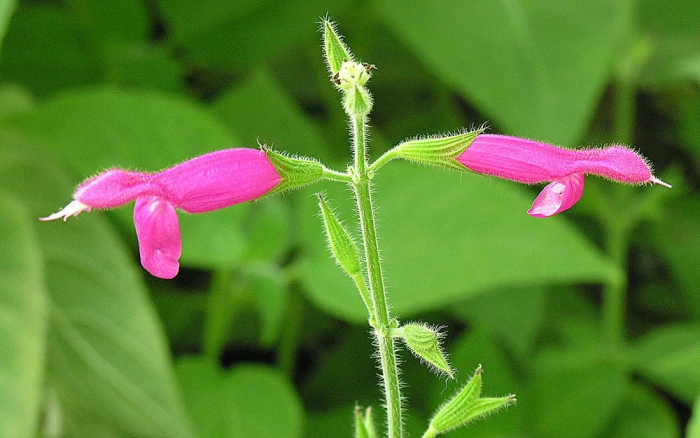Fruit-Scented Sage
(Salvia dorisiana)
Fruit-Scented Sage (Salvia dorisiana)
/
/

Dick Culbert
CC BY 2.0
Image By:
Dick Culbert
Recorded By:
Copyright:
CC BY 2.0
Copyright Notice:
Photo by: Dick Culbert | License Type: CC BY 2.0 | License URL: https://creativecommons.org/licenses/by-sa/2.0/ | Uploader: Dick Culbert | Publisher: Flickr |





Estimated Native Range
Summary
Salvia dorisiana, commonly known as Fruit-Scented Sage, is a perennial shrub native to the cloud forests of Honduras. It typically grows 1–1.3 meters tall and is heavily branched, creating a lush, rounded form. The leaves are notable for their fruity scent, reminiscent of pineapple and grapefruit, which is released when brushed against. This species is particularly admired for its large magenta-pink flowers that bloom in the winter months, adding a splash of color during a season when few plants flower. Each flower can reach up to 5 cm in length and is complemented by a lime-green calyx of similar length. The entire plant is covered with glandular hairs that contribute to its aromatic qualities.
Fruit-Scented Sage is a popular choice for greenhouses and indoor gardens due to its attractive foliage, delightful fragrance, and vibrant flowers. It is also used in outdoor gardens in warmer climates. While it can tolerate low to medium water conditions, it thrives in well-draining soil and benefits from full sun exposure to partial shade. Gardeners should be aware that it may require protection from frost and is best grown in regions where temperatures do not drop significantly. This Salvia is not known for any significant disease issues, but overwatering can lead to root rot. It is not typically invasive but should be monitored to ensure it does not spread beyond its intended area.CC BY-SA 4.0
Fruit-Scented Sage is a popular choice for greenhouses and indoor gardens due to its attractive foliage, delightful fragrance, and vibrant flowers. It is also used in outdoor gardens in warmer climates. While it can tolerate low to medium water conditions, it thrives in well-draining soil and benefits from full sun exposure to partial shade. Gardeners should be aware that it may require protection from frost and is best grown in regions where temperatures do not drop significantly. This Salvia is not known for any significant disease issues, but overwatering can lead to root rot. It is not typically invasive but should be monitored to ensure it does not spread beyond its intended area.CC BY-SA 4.0
Plant Description
- Plant Type: Shrub
- Height: 2.5-3.5 feet
- Width: 1.7-2 feet
- Growth Rate: Moderate
- Flower Color: Pink
- Flowering Season: Spring, Winter
- Leaf Retention: Evergreen
Growth Requirements
- Sun: Full Sun
- Water: Low, Medium
- Drainage: Medium
Common Uses
Bee Garden, Bird Garden, Butterfly Garden, Deer Resistant, Drought Tolerant, Edible*Disclaimer: Easyscape's listed plant edibility is for informational use. Always verify the safety and proper identification of any plant before consumption., Fragrant, Groundcover, Hummingbird Garden, Low Maintenance, Rabbit Resistant, Salt Tolerant, Street Planting
Natural Habitat
Cloud forests of Honduras
Other Names
Common Names: Peach Sage
Scientific Names: , Salvia dorisiana,
GBIF Accepted Name: Salvia dorisiana Standl.